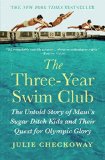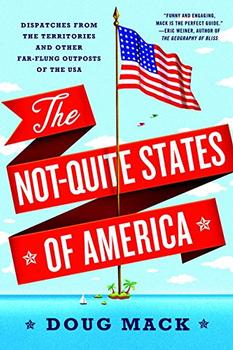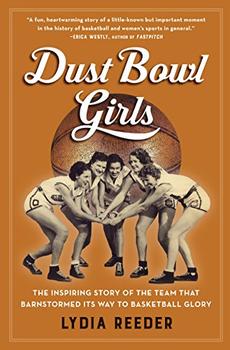Summary | Excerpt | Reviews | Beyond the book | Read-Alikes | Genres & Themes | Author Bio

The Untold Story of Maui's Sugar Ditch Kids and Their Quest for Olympic Glory
by Julie CheckowayThis is a feel-good story about the determination of a humble Japanese-American schoolteacher, Soichi Sakamoto, who barely knew how to swim himself but taught the sport to underprivileged children living on the sugar plantations of Hawaii during the 1930s and 1940s. In the preface, author Julie Checkoway shares the challenges faced in researching this complex story. The participants did not write their own recollections and instead relied only on oral sharing over the years, mostly because no one person felt ownership of a story that belonged to a team with many members. It was up to an outsider, compelled to ensure this story is not entirely forgotten, to put together the pieces. As Checkoway says in the preface, "History isn't a sculptured cup; it's more like a sieve through which so many stories pass and disappear."
Coach Sakamoto is introduced as a restless boy and defiant teen, longing for a bigger life than the one set for him on the rural island of Maui. As he matures, his desire for grandeur and fame is channeled into shaping the fates of the impoverished and overlooked children of the Pu'unene sugarcane plantation workers. The descriptions of plantation life are grim, "as close as one could get to slavery." Besides the grueling work with little pay, hunger and disease were common. The children were left largely unsupervised to design their own, often dangerous, forms of entertainment.
One favorite pastime of the children was swimming in the extremely hazardous irrigation ditches, in the swift currents that often carried potentially lethal objects along the stream. After witnessing the kids' play —and the subsequent whipping that followed for anyone caught by the supervising plantation boss—Sakamoto offered to watch the children if they were allowed to splash and play for an hour each day. Although he himself was a weak swimmer, he taught the children to hold their breath under water and to float, and finally to move their arms and legs in what he called, "speed-floating." This rough and ragged swim club provided children a supervised place to be after school, a chance to grow strong, and a way to learn the value of goal-setting and personal achievement. Sakamoto received no extra pay for providing this invaluable service and, in fact, spent his own money feeding and providing equipment such as the rough kickboards and "resistance arm-weight" gadget he devised for training. He even saved and bought a car so he could transport the children—sometimes cramming almost twenty children inside—to an actual pool where they could learn to do wall turns.
As the children grew stronger, Sakamoto's dreams did too. In June 1937, he came up with the idea of a Three-Year Swim Club (3YSC) and challenged his students to sign up. For three years, they would practice regularly, with obedience and discipline, aiming to qualify for the 1940 Olympics, scheduled to take place in Tokyo, Japan—the ancestral home for many of the young athletes. These games were canceled once Japan invaded China. Even without that particular goal—and the subsequent cancellation of the 1944 Olympics as well—Sakamoto and his athletes kept on, despite world tensions brewing from World War II.
Throughout, Sakamoto straddled the line between cultural pride and acceptance of societal prejudices. His team, made up of Hawaiian and Japanese-American athletes, always conducted themselves in a dignified manner, determined not to allow any negative associations of the people they represented. Although Sakamoto's achievements as a coach are truly stunning, Checkoway hints at the personal sacrifices he made in other relationships. She intimates that his relationships with his own children were limited and distant. His brother died in a boating accident because of the tragically ironic fact that he had never been taught to swim. A student athlete, Halo Hirose, grew to resent him over the years, feeling as if he was not given enough attention and support.
At times, I felt the story wandered a little too wide. For instance, a number of pages are dedicated to the individuals behind the failed 1940 Olympics. Although a somewhat interesting look at the politics, seeing as those games were canceled for reasons beyond these individuals' control, the relevance of their actions is lost.
The specific swimming achievements and records should satisfy fans of the sport, while the general significance is made clear for readers who aren't concerned with the statistics. As someone who does not read a lot of nonfiction, I found this to be a compelling, character-driven story. The conflicts of success—competitors' jealousy and the desire to capitalize on Sakamoto's achievements add a certain literary drama.
There is not a lot of focus on the later lives of the swim club members, but there are hints. Several attended college on swim scholarships, something that most likely would never have been possible for a plantation worker's child. It is also validating and satisfying to learn that Soichi Sakamoto was recognized for his stellar coaching skills and recruited to serve as a swim coach for the University of Hawaii.
Sakamoto's decision to teach underprivileged children to swim and to challenge them to dream, changed hundreds of lives for the better. I was deeply moved by the fact that so many benefitted from his firm but compassionate attention and coaching. The final scene, focused on student Keo Nakama thirteen years later is inspiring. As he struggles to be the first person to swim the twenty-seven mile Kaiwi channel between the islands of Molokai and Maui, Nakama draws on the lessons learned from Sakamoto, proving that a good coach's influence lasts a lifetime.
![]() This review was originally published in The BookBrowse Review in January 2016, and has been updated for the
June 2016 edition.
Click here to go to this issue.
This review was originally published in The BookBrowse Review in January 2016, and has been updated for the
June 2016 edition.
Click here to go to this issue.

If you liked The Three-Year Swim Club, try these:

The Not-Quite States of America
by Doug Mack
Published 2018
An eye-opening journey to the most overlooked parts of America.

by Lydia Reeder
Published 2017
The Boys in the Boat meets A League of Their Own in this true story of a Depression-era championship women's team.




Men are more moral than they think...
Click Here to find out who said this, as well as discovering other famous literary quotes!
Your guide toexceptional books
BookBrowse seeks out and recommends the best in contemporary fiction and nonfiction—books that not only engage and entertain but also deepen our understanding of ourselves and the world around us.